Different Woods in Cooperage for Oenology: A Review
Abstract
1. Introduction
2. Oak Species Not Traditionally Used in Cooperage
2.1. Pyrenaica Oak (Quercus Pyrenaica Willd)
2.2. Quercus Faginea Lam
2.3. Quercus Frainetto Ten
2.4. Quercus Oocarpa Liebm
2.5. Quercus Humboldtii Bonpl
3. Woods Not Traditionally Used in Cooperage Different to Oak
3.1. Castanea Sativa Mill
3.2. Robinia Pseudoacacia L., (False Acacia)
3.3. Prunus
3.4. Fraxinus
3.5. Morus (Mulberry)
4. Chemical Composition of the Extractable Fraction of the Different Woods
Author Contributions
Funding
Acknowledgments
Conflicts of Interest
References
- Gautier, J.F. Histoire et Actualité Du Tonneau. Rev. Française D’oenologie 2000, 181, 33–35. [Google Scholar]
- Gautier, J.F. Le Tonneau à Travers Les âGes. Rev. Oenologues Tech. Vitivinic. Oenologicques 2003, 30, 13–15. [Google Scholar]
- Vivas, N.; Saint-Cricq de Gaulejac, N. The useful lifespan of new barrels and risk related to the use of old barrels. Aust. N. Z. Wine Ind. J. 1999, 14, 37–45. [Google Scholar]
- Singleton, V.L. Le Stockage Des Vins En Barriques: Utilisation et Variables Significatives. J. Sci. Tech. Tonnellerie 2000, 6, 1–25. [Google Scholar]
- Fernández de Simón, B.; Cadahía, E. Utilización Del Roble Español en el Envejecimiento de Vinos: Comparación con Roble Francés y Americano; Instituto Nacional de Investigación y Tecnología Agraria y Alimentaria Ministerio de Educación y Ciencia: Madrid, Spain, 2004. [Google Scholar]
- Chira, K.; Teissedre, P.-L. Chemical and sensory evaluation of wine matured in oak barrel: Effect of oak species involved and toasting process. Eur. Food Res. Technol. 2015, 240, 533–547. [Google Scholar] [CrossRef]
- Cadahía, E.; Muñoz, L.; De Simón, B.F.; García-Vallejo, M.C. Changes in low molecular weight phenolic compounds in Spanish, French, and American oak woods during natural seasoning and toasting. J. Agric. Food Chem. 2001, 49, 1790–1798. [Google Scholar] [CrossRef] [PubMed]
- Cadahía, E.; Varea, S.; Muñoz, L.; Fernández de Simón, B.; García-Vallejo, M.C. Evolution of ellagitannins in Spanish, French, and American oak woods during natural seasoning and toasting. J. Agric. Food Chem. 2001, 49, 3677–3684. [Google Scholar] [CrossRef] [PubMed]
- Fernández de Simón, B.; Hernández, T.; Cadahía, E.; Dueñas, M.; Estrella, I. Phenolic compounds in a Spanish red wine aged in barrels made of Spanish, French and American oak wood. Eur. Food Res. Technol. 2003, 216, 150–156. [Google Scholar] [CrossRef]
- Fernández De Simón, B.; Cadahía, E.; Jalocha, J. Volatile compounds in a Spanish red wine aged in barrels made of Spanish, French, and American oak wood. J. Agric. Food Chem. 2003, 51, 7671–7678. [Google Scholar] [CrossRef] [PubMed]
- Cadahía, E.; Fernández de Simón, B.; Sanz, M.; Poveda, P.; Colio, J. Chemical and chromatic characteristics of Tempranillo, Cabernet Sauvignon and Merlot wines from DO Navarra aged in Spanish and French oak barrels. Food Chem. 2009, 115, 639–649. [Google Scholar] [CrossRef]
- Guchu, E.; Díaz-Maroto, M.C.; Pérez-Coello, M.S.; González-Viñas, M.A.; Ibáñez, M.D.C. Volatile composition and sensory characteristics of chardonnay wines treated with American and Hungarian oak chips. Food Chem. 2006, 99, 350–359. [Google Scholar] [CrossRef]
- Díaz-Maroto, M.C.; Guchu, E.; Castro-Vázquez, L.; de Torres, C.; Pérez-Coello, M.S. Aroma-active compounds of American, French, Hungarian and Russian oak woods, Studied by GC–MS and GC–O. Flavour Fragr. J. 2008, 23, 93–98. [Google Scholar] [CrossRef]
- Mosedale, J.R.; Ford, A. Variation of the flavour and extractives of european oak wood from two French forests. J. Sci. Food Agric. 1996, 70, 273–287. [Google Scholar] [CrossRef]
- Prida, A.; Puech, J.-L. Influence of geographical origin and botanical species on the content of extractives in American, French, and East European oak woods. J. Agric. Food Chem. 2006, 54, 8115–8126. [Google Scholar] [CrossRef] [PubMed]
- Martínez-Gil, A.M.; Cadahía, E.; Fernández De Simón, B.; Gutiérrez-Gamboa, G.; Nevares, I.; Alamo-Sanza, M. Quercus Humboldtii (Colombian Oak): Characterization of oak heartwood phenolic composition with respect to traditional oak woods in oenology. Ciência Técnica Vitivinícola 2017, 32, 93–101. [Google Scholar] [CrossRef]
- Martínez-Gil, A.; Cadahía, E.; Fernández de Simón, B.; Gutiérrez-Gamboa, G.; Nevares, I.; del Álamo-Sanza, M. Phenolic and volatile compounds in Quercus Humboldtii Bonpl. Wood: Effect of toasting with respect to oaks traditionally used in cooperage. J. Sci. Food Agric. 2018. [Google Scholar] [CrossRef]
- Singleton, V.L. Some aspects of the wooden container as a factor in wine maturation. Chem. Winemak. Adv. Chem. Ser. 1974, 137, 254–277. [Google Scholar]
- Taransaud, J. Le Livre de La Tonnellerie; La Roue à Livres Diffusion: París, France, 1976. [Google Scholar]
- Cazenave de la Roche, A. La Tonelería En El Contexto Marítimo de La Época Del Renacimiento: Estudio de Un Cargamento de Toneles Hallado En El Pecio de Villefranche s/Mer (1516). In Actas de la XIVa Conferencia Nacional de Arqueología Argentina; Universidad Nacional de Tucumán: Rosario, Argentina, 2004; pp. 1–17. [Google Scholar]
- Vivas, N. Manual De Tonelería: Destinado A Usuarios De Toneles; Mundi, Pre: Madrid, Spain, 2005. [Google Scholar]
- Feuillat, F.; Keller, R. Variability of Oak Wood (Quercus Robur L., Quercus Petraea Liebl.) Anatomy relating to cask properties. Am. J. Enol. Vitic. 1997, 48, 502–508. [Google Scholar]
- Cadahía, E.; Fernández de Simón, B.; Poveda, P.; Sanz, M. Utilización de Quercus Pyrenaica Willd. de Castilla y León En El Envejecimiento de Vinos. Comparación Con Roble Francés y Americano; Instituto Nacional de Investigación y Tecnología Agraria y Alimentaria Ministerio de Educación y Ciencia: Madrid, Spain, 2008. [Google Scholar]
- Timbal, J.; Kremer, A. Caractères Botaniques, Morphologiques et Clorologiques. In Le chêne rouge d´Amérique; Dremer, J.T., Le Goff, A., Nepveu, G., Eds.; INRA: París, France, 1994; pp. 45–53. [Google Scholar]
- Fernández-Golfín, J.I.; Cadahía, E. Características Físicas y Químicas de La Madera de Roble En La Fabricación de Barricas; Gobierno de la Rioja: L. La Rioja, Spain, 1999; pp. 11–66. [Google Scholar]
- Philp, J. Cask Quality and Warehouse Conditions. In The Science and Technology of Whiskies; Piggott, J.R., Sharp, R., Duncan, R.E.B., Eds.; Longman Scientific & Technical: Harlow, Essex, UK, 1989; pp. 264–294. [Google Scholar]
- Fernández de Simón, B.; Sanz, M.; Cadahía, E.; Poveda, P.; Broto, M. Chemical characterization of oak heartwood from Spanish forests of Quercus Pyrenaica (Wild.). Ellagitannins, Low Molecular Weight Phenolic, and Volatile Compounds. J. Agric. Food Chem. 2006, 54, 8314–8321. [Google Scholar] [CrossRef] [PubMed]
- Fernández de Simón, B.; Cadahía, E.; Conde, E.; García-Vallejo, M.C. Evolution of phenolic compounds of Spanish oak wood during natural seasoning. First Results. J. Agric. Food Chem. 1999, 47, 1687–1694. [Google Scholar] [CrossRef] [PubMed]
- Fernández de Simón, B.; Cadahía, E.; Conde, E.; García-Vallejo, M.C. Ellagitannins in woods of Spanish, French and American oaks. Holzforschung 1999, 53, 147–150. [Google Scholar]
- Fernández de Simón, B.; Cadahía, E.; Conde, E.; García-Vallejo, M.C. Low molecular weight phenolic compounds in Spanish oak woods. J. Agric. Food Chem. 1996, 44, 1507–1511. [Google Scholar] [CrossRef]
- Alañón, M.E.; Castro-Vázquez, L.; Díaz-Maroto, M.C.; Hermosín-Gutiérrez, I.; Gordon, M.H.; Pérez-Coello, M.S. Antioxidant capacity and phenolic composition of different woods used in cooperage. Food Chem. 2011, 129, 1584–1590. [Google Scholar] [CrossRef]
- Jordão, A.M.; Ricardo-Da-Silva, J.M.; Laureano, O. Ellagitannins from Portuguese Oak Wood (Quercus Pyrenaica Willd.) Used in Cooperage: Influence of geographical origin, coarseness of the grain and toasting level. Holzforschung 2007, 61, 155–160. [Google Scholar] [CrossRef]
- Castro-Vázquez, L.; Alañón, M.E.; Ricardo-Da-Silva, J.M.; Pérez-Coello, M.S.; Laureano, O. Study of phenolic potential of seasoned and toasted Portuguese wood species (Quercus Pyrenaica and Castanea Sativa). J. Int. des Sci. la Vigne du Vin 2013, 47, 311–319. [Google Scholar] [CrossRef]
- Canas, S.; Leandro, M.C.; Spranger, M.I.; Belchior, A.P. Influence of botanical species and geographical origin on the content of low molecular weight phenolic compounds of woods used in Portuguese cooperage. Holzforschung 2000, 54, 255–261. [Google Scholar] [CrossRef]
- Canas, S.; Grazina, N.; Belchior, A.P.; Spranger, M.I.; de Sousa, R.B.; Sousa, R.B.D. Modelisation of heat treatment of Portuguese oak wood (Quercus Pyrenaica L.). Analysis of the behaviour of low molecular weight phenolic compounds. Ciência Técnica Vitivinícola 2000, 15, 75–94. [Google Scholar]
- Vivas, N.; Glories, Y.; Bourgeois, G.; Vitry, C. The heartwood ellagitannins of different oaks (Quercus Sp.) and chestnut species (Castanea Sativa Mill.). Quantity analysis of red wines aging in barrels. J. Sci. Tech. Tonnelerie 1996, 2, 25–75. [Google Scholar]
- Sanz, M.; Cadahía, E.; Esteruelas, E.; Muñoz, Á.M.; Fernández De Simón, B.; Hernández, T.; Estrella, I. Phenolic compounds in chestnut (Castanea Sativa Mill.) heartwood. Effect of toasting at cooperage. J. Agric. Food Chem. 2010, 58, 9631–9640. [Google Scholar] [CrossRef] [PubMed]
- Viriot, C.; Scalbert, A.; Hervé du Penhoat, C.L.M.; Moutounet, M. Ellagitannins in woods of sessile oak and sweet chestnut dimerization and hydrolysis during wood ageing. Phytochemistry 1994, 36, 1253–1260. [Google Scholar] [CrossRef]
- Canas, S.; Leandro, M.C.; Spranger, M.I.; Belchior, A.P. Low molecular weight organic compounds of chestnut wood (Castanea Sativa L.) and corresponding aged brandies. J. Agric. Food Chem. 1999, 47, 5023–5030. [Google Scholar] [CrossRef] [PubMed]
- Soares, B.; Garcia, R.; Freitas, A.M.C.; Cabrita, M.J. Phenolic compounds released from oak, cherry, chestnut and robinia chips into a syntethic wine: Influence of toasting level. Ciência Técnica Vitivinic 2012, 27, 17–26. [Google Scholar]
- Canas, S.; Caldeira, I.; Mateus, A.M.; Belchior, A.P.; Clímaco, M.C.; Bruno-de-Sousa, R. Effect of natural seasoning on the chemical composition of chestnut wood used for barrel making. Ciência Técnica Vitivinic 2006, 21, 1–16. [Google Scholar]
- Sanz, M.; Fernández de Simón, B.; Esteruelas, E.; Muñoz, A.M.; Cadahía, E.; Hernández, T.; Estrella, I.; Pinto, E. Effect of toasting intensity at cooperage on phenolic compounds in acacia (Robinia Pseudoacacia) heartwood. J. Agric. Food Chem. 2011, 59, 3135–3145. [Google Scholar] [CrossRef] [PubMed]
- Sanz, M.; Fernández de Simón, B.; Cadahía, E.; Esteruelas, E.; Muñoz, Á.M.; Teresa Hernández, M.; Estrella, I. Polyphenolic profile as a useful tool to identify the wood used in wine aging. Anal. Chim. Acta 2012, 732, 33–45. [Google Scholar] [CrossRef] [PubMed]
- Sanz, M.; Cadahía, E.; Esteruelas, E.; Muñoz, M.; Fernández De Simón, B.; Hernández, T.; Estrella, I. Phenolic compounds in cherry (Prunus avium) heartwood with a view to their use in cooperage. J. Agric. Food Chem. 2010, 58, 4907–4914. [Google Scholar] [CrossRef] [PubMed]
- Sanz, M.; De Simón, B.F.; Cadahía, E.; Esteruelas, E.; Muñoz, A.M.; Hernández, T.; Estrella, I.; Pinto, E. LC-DAD/ESI-MS/MS study of phenolic compounds in ash (Fraxinus Excelsior L. and F. Americana L.) heartwood. effect of toasting intensity at cooperage. J. Mass Spectrom. 2012, 47, 905–918. [Google Scholar] [CrossRef] [PubMed]
- Jordão, A.M.; Lozano, V.; Correia, A.C.; Ortega-Heras, M.; González-SanJosé, M.L. Comparative analysis of volatile and phenolic composition of alternative wood chips from cherry, acacia and oak for potential use in enology. BIO Web Conf. 2016, 7, 02012. [Google Scholar] [CrossRef]
- Canas, S.; Belchior, A.P.; Falcão, A.; Gonçalves, J.A.; Spranger, M.I.; Bruno-De-Sousa, R. Effect of heat treatment on the thermal and chemical mofifications of oak and chestnut wood used in brandy ageing. Ciência Técnica Vitivinic 2007, 22, 5–14. [Google Scholar]
- Madrera, R.R.; Valles, B.S.; García, Y.D.; Argüelles, P.D.V.; Lobo, A.P. Alternative woods for aging distillates -an insight into their phenolic profiles and antioxidant activities. Food Sci. Biotechnol. 2010, 19, 1129–1134. [Google Scholar] [CrossRef]
- Sanz, M.; Fernández de Simón, B.; Esteruelas, E.; Muñoz, Á.M.; Cadahía, E.; Teresa Hernández, M.; Estrella, I.; Martinez, J. Polyphenols in red wine aged in acacia (Robinia Pseudoacacia) and oak (Quercus Petraea) wood barrels. Anal. Chim. Acta 2012, 732, 83–90. [Google Scholar] [CrossRef] [PubMed]
- Cadahía, E.; De Simón, B.F.; Vallejo, R.; Sanz, M.; Broto, M. Volatile compound evolution in Spanish oak wood (Quercus Petraea and Quercus Pyrenaica) during natural seasoning. Am. J. Enol. Vitic. 2007, 58, 163–172. [Google Scholar]
- Cadahía, E.; Fernández de Simón, B.; Jalocha, J. Volatile compounds in Spanish, French, and American oak woods after natural seasoning and toasting. J. Agric. Food Chem. 2003, 51, 5923–5932. [Google Scholar] [CrossRef] [PubMed]
- Alañón, M.E.; Pérez-Coello, M.S.; Díaz-Maroto, I.J.; Martín-Alvarez, P.J.; Vila-Lameiro, P.; Díaz-Maroto, M.C. Influence of geographical location, site and silvicultural parameters, on volatile composition of Quercus Pyrenaica Willd. Wood used in wine aging. For. Ecol. Manag. 2011, 262, 124–130. [Google Scholar] [CrossRef]
- Caldeira, I.; Clímaco, M.C.; Bruno De Sousa, R.; Belchior, A.P. Volatile composition of oak and chestnut woods used in brandy ageing: Modification induced by heat treatment. J. Food Eng. 2006, 76, 202–211. [Google Scholar] [CrossRef]
- Jordao, A.M.; Ricardo-Da-Silva, J.M.; Laureano, O. Comparison of volatile composition of cooperage oak wood of different origins (Quercus Pyrenaica vs. Quercus Alba and Quercus Petraea). Mitteilungen Klosterneubg. 2005, 55, 22–31. [Google Scholar]
- De Simon, B.F.; Esteruelas, E.; Muñoz, À.M.; Cadahía, E.; Sanz, M. Volatile compounds in acacia, chestnut, cherry, ash, and oak woods, with a view to their use in cooperage. J. Agric. Food Chem. 2009, 57, 3217–3227. [Google Scholar] [CrossRef] [PubMed]
- Flamini, R.; Dalla Vedova, A.; Cancian, D.; Panighel, A.; De Rosso, M. GC/MS-positive ion chemical ionization and MS/MS study of volatile benzene compounds in five different woods used in barrel making. J. Mass Spectrom. 2007, 42, 641–646. [Google Scholar] [CrossRef] [PubMed]
- Fernández De Simõn, B.; Sanz, M.; Cadahía, E.; Esteruelas, E.; Muñoz, A.M. Nontargeted GC-MS approach for volatile profile of toasting in cherry, chestnut, false acacia, and ash wood. J. Mass Spectrom. 2014, 49, 353–370. [Google Scholar] [CrossRef] [PubMed]
- Fernández de Simón, B.; Cadahía, E.; del Álamo, M.; Nevares, I. Effect of size, seasoning and toasting in the volatile compounds in toasted oak wood and in a red wine treated with them. Anal. Chim. Acta 2010, 660, 211–220. [Google Scholar] [CrossRef] [PubMed]
- Fernández De Simón, B.; Muiño, I.; Cadahía, E. Characterization of volatile constituents in commercial oak wood chips. J. Agric. Food Chem. 2010, 58, 9587–9596. [Google Scholar] [CrossRef] [PubMed]
- Fernández de Simón, B.; Cadahía, E.; Muiño, I.; del Álamo, M.; Nevares, I. Volatile composition of toasted oak chips and staves and of red wine aged with them. Am. J. Enol. Vitic. 2010, 61, 157–165. [Google Scholar]
- III-IFE (Inventario Forestal Español) (Ed.) Ministerio de Medio Ambiente; Direccíon General de Conservación de la Naturaleza: Madrid, Spain, 2002. [Google Scholar]
- Caudullo, G.; Welk, E.; San-Miguel-Ayanz, J. Chorological Maps for the Main European Woody Species. Data Brief 2017, 12, 662–666. [Google Scholar] [CrossRef] [PubMed]
- Fernández de Simón, B.; Cadahía, E.; Conde, E.; García-Vallejo, M.C. Ellagitannins in woods of Spanish oaks. J. Sci. Tech. Tonnellerie 1998, 4, 91–97. [Google Scholar]
- Fernández de Simón, B.; Cadahía, E.; Conde, E.; García-Vallejo, M.C. Low molecular weight phenolic compounds in woods of Spanish, French and American oak. J. Sci. Tech. Tonnelerie 1996. [Google Scholar]
- Jordão, A.M.; Ricardo-Da-Silva, J.M.; Laureano, O.; Adams, A.; Demyttenaere, J.; Verhé, R.; De Kimpe, N. Volatile composition analysis by solid-phase microextraction applied to oak wood used in cooperage (Quercus Pyrenaica and Quercus Petraea): Effect of botanical species and toasting process. J. Wood Sci. 2006, 52, 514–521. [Google Scholar] [CrossRef]
- Canas, S. Phenolic composition and related properties of aged wine spirits: Influence of barrel characteristics. A Review. Beverages 2017, 3, 55. [Google Scholar] [CrossRef]
- Canas, S.; Silva, V.; Belchior, A.P. Wood related chemical markers of aged wine brandies. Ciência Técnica Vitivinícola 2008, 23, 45–52. [Google Scholar]
- Caldeira, I.; Belchior, A.P.; Clímaco, M.C.; Bruno De Sousa, R. Aroma profile of Portuguese brandies aged in chestnut and oak woods. Anal. Chim. Acta 2002, 458, 55–62. [Google Scholar] [CrossRef]
- Caldeira, I.; de Sousa, R.B.; Belchior, A.P.; Climaco, M.C. A Sensory and chemical approach to the aroma of wooden agend lourinha wine brandy. Ciencia Tecnica 2008, 23, 97–110. [Google Scholar]
- Carvalho, E.; Belchior, A.P.; Costa, S.; Caldeira, I.; Tralhao, I. Incidência Da Origem e Queima Da Madeira de Carvalho (“Q. Pyrenaica, Q. Robur, Q. Sessiliflora, Q. Alba/Q. Stellata + Q. Lyrata/Q.Bicolor”) e de Castanho (“C. Sativa”) Em Características Físico-Químicas e Organolépticas de Aguardentes Lourinha Em Envelhecim. Ciência Técnica Vitivinícola 1998, 13, 107–119. [Google Scholar]
- Tavares, M.; Jordão, A.M.; Ricardo-Da-Silva, J.M. Impact of cherry, acacia and oak chips on red wine phenolic parameters and sensory profile. OENO ONE 2017, 51, 329–342. [Google Scholar] [CrossRef]
- Sánchez-Gómez, R.; Nevares, I.; Martínez-Gil, A.; del Alamo-Sanza, M. Oxygen consumption by red wines under different micro-oxygenation strategies and Q. Pyrenaica chips. Effects on color and phenolic characteristics. Beverages 2018, 4, 69. [Google Scholar] [CrossRef]
- Del Álamo, M.; Nevares, I.; Gallego, L.; Fernández de Simón, B.; Cadahía, E. Micro-oxygenation strategy depends on origin and size of oak chips or staves during accelerated red wine aging. Anal. Chim. Acta 2010, 660, 92–101. [Google Scholar] [CrossRef] [PubMed]
- Rodríguez-Bencomo, J.J.; Ortega-Heras, M.; Pérez-Magariño, S.; González-Huerta, C. Volatile compounds of red wines macerated with Spanish, American, and French oak chips. J. Agric. Food Chem. 2009, 57, 6383–6391. [Google Scholar] [CrossRef] [PubMed]
- Gonalves, F.J.; Jordao, A.M. Changes in antioxidant activity and the proanthocyanidin fraction of red wine aged in contact with Portuguese (Quercus Pyrenaica Willd.) and American (Quercus Alba L.) oak wood chips. Ital. J. Food Sci. 2009, 21, 51–64. [Google Scholar]
- De Simón, B.F.; Cadahía, E.; Sanz, M.; Poveda, P.; Perez-Magariño, S.; Ortega-Heras, M.; González-Huerta, C. Volatile compounds and sensorial characterization of wines from four Spanish denominations of origin, aged in Spanish rebollo (Quercus Pyrenaica Willd.) oak wood barrels. J. Agric. Food Chem. 2008, 56, 9046–9055. [Google Scholar] [CrossRef] [PubMed]
- Coninck, G.D.E.; Jordão, A.M.; Ricardo-Da-Silva, J.M.; Laureano, O. Evolution of phenolic composition and sensory properties in red wine aged in contact with Portuguese. J. Int. des Sci. de la vigne et du vin 2006, 40, 25–34. [Google Scholar]
- Fernández De Simón, B.; Cadahía, E.; Hernández, T.; Estrella, I. Evolution of oak-related volatile compounds in a Spanish red wine during 2 years bottled, after aging in barrels made of Spanish, French and American oak wood. Anal. Chim. Acta 2006, 563, 198–203. [Google Scholar] [CrossRef]
- Gallego, L.; Del Alamo, M.; Nevares, I.; Fernández, J.A.; De Simón, B.F.; Cadahía, E. Phenolic Compounds and Sensorial Characterization of Wines Aged with Alternative to Barrel Products Made of Spanish Oak Wood (Quercus Pyrenaica Willd.). Food Sci. Technol. Int. 2012, 18, 151–165. [Google Scholar] [CrossRef] [PubMed]
- Miranda, I.; Sousa, V.; Ferreira, J.; Pereira, H. Chemical characterization and extractives composition of heartwood and sapwood from Quercus Faginea. PLoS ONE 2017, 12, 1–14. [Google Scholar] [CrossRef] [PubMed]
- Ministerio de Medioambiente. Plan Forestal Español; Ministerio de Medioambiente: Madrid, Spain, 2002.
- Reboredo, F.; Pais, J. Evolution of forest cover in Portugal: A review of the 12th–20th centuries. J. For. Res. 2014, 25, 249–256. [Google Scholar] [CrossRef]
- Mauri, A.; Enescu, C.M.; Houston Durrant, T.; de Rigo, D.; Caudullo, G. Quercus Frainetto in Europe: Distribution, Habitat, Usage and Threats. In European Atlas of Forest Tree Species; San-Miguel-Ayanz, J., de Rigo, D., Caudullo, G., Houston Durrant, T., Mauri, A., Eds.; Publication Office of the European Union: Luxembourg, 2016; pp. 1–78. [Google Scholar]
- Madrigal-Jiménez, T.A. Fenología y Ecofisiología Del Quercus Oocarpa (Fagaceae), Cartago, Costa Rica. Rev. Biol. Trop. 1996, 44, 117–123. [Google Scholar]
- Andrés, A.M.; Luis Mario, C.C. Conservation and Sustainable Use of Oak Forests in the Conservation Corridor Guantiva-La Rusia—Iguaque, Santander and Boyac, Colombia. Colomb. For. 2010, 13, 5–30. [Google Scholar]
- Argoti, J.C.; Salido, S.; Linares-Palomino, P.J.; Ramírez, B.; Insuasty, B.; Altarejos, J. Antioxidant activity and free radical-scavenging capacity of a selection of wild-growing colombian plants. J. Sci. Food Agric. 2011, 91, 2399–2406. [Google Scholar] [CrossRef] [PubMed]
- González, R.E.; Baleta, L.C. Quantification and comparison of ageing markers substances of accelerated aging rums and in oak (Quercus Humboldtii Bonpland) barrels. Rev. Venez. Cienc. Tecnol. Aliment. 2010, 1, 170–183. [Google Scholar]
- González, R.E.; Calderón, L.S.; Cabeza, R.A. Quantification of aging markers substances in Quercus Humboldtii through high efficiency liquid chromatography. Temas Agrar. 2008, 13, 56–63. [Google Scholar] [CrossRef]
- Martínez-Gil, A.M.; del Alamo-Sanza, M.; Gutiérrez-Gamboa, G.; Moreno-Simunovic, Y.; Nevares, I. Volatile composition and sensory characteristics of Carménère wines macerating with Colombian (Quercus Humboldtii) oak chips compared to wines macerated with American (Q. Alba) and European (Q. Petraea) oak chips. Food Chem. 2018, 266, 90–100. [Google Scholar] [CrossRef] [PubMed]
- Gortzi, O.; Metaxa, X.; Mantanis, G.; Lalas, S. Effect of artificial ageing using different wood chips on the antioxidant activity, resveratrol and catechin concentration, sensory properties and colour of two greek red wines. Food Chem. 2013, 141, 2887–2895. [Google Scholar] [CrossRef] [PubMed]
- Canas, S.; Caldeira, I.; Belchior, A.P. Extraction/Oxidation kinetics of low molecular weight compounds in wine brandy resulting from different ageing technologies. Food Chem. 2013, 138, 2460–2467. [Google Scholar] [CrossRef] [PubMed]
- De Rosso, M.; Cancian, D.; Panighel, A.; Dalla Vedova, A.; Flamini, R. Chemical compounds released from five different woods used to make barrels for aging wines and spirits: Volatile compounds and polyphenols. Wood Sci. Technol. 2009, 43, 375–385. [Google Scholar] [CrossRef]
- Peng, S.; Scalbert, A.; Monties, B. Insoluble ellagitannins in castanea sativa and quercus petraea woods. Phytochemistry 1991, 30, 775–778. [Google Scholar] [CrossRef]
- Caldeira, I.; Anjos, O.; Belchior, A.P.; Canas, S. Sensory Impact of alternative ageing technology for the production of wine brandies. Ciência Técnica Vitivinícola 2017, 32, 12–22. [Google Scholar] [CrossRef]
- Caldeira, I.; Santos, R.; Ricardo-Da-Silva, J.M.; Anjos, O.; Mira, H.; Belchior, A.P.; Canas, S. Kinetics of odorant compounds in wine brandies aged in different systems. Food Chem. 2016, 211, 937–946. [Google Scholar] [CrossRef] [PubMed]
- Anjos, O.; Carmona, C.; Caldeira, I.; Canas, S. Variation of extractable compounds and lignin contents in wood fragments used in the aging of wine brandies. BioResources 2013, 8, 4484–4496. [Google Scholar] [CrossRef]
- Caldeira, I.; Belchior, A.P.; Canas, S. Effect of alternative ageing systems on the wine brandy sensory profile. Ciência Técnica Vitivinícola 2013, 28, 9–18. [Google Scholar]
- Caldeira, I.; Anjos, O.; Portal, V.; Belchior, A.P.; Canas, S. Sensory and chemical modifications of wine-brandy aged with chestnut and oak wood fragments in comparison to wooden barrels. Anal. Chim. Acta 2010, 660, 43–52. [Google Scholar] [CrossRef] [PubMed]
- Canas, S.; Caldeira, I.; Belchior, A.P. Comparison of alternative systems for the ageing of wine brandy. Oxygenation and wood shape effect. Ciência Técnica Vitivinícola 2009, 24, 91–99. [Google Scholar]
- Canas, S.; Caldeira, I.; Belchior, A.P.; Spranger, M.I.; Clímaco, M.C.; Bruno-de-Sousa, R. Chestnut Wooden Barrels for the Ageing of Wine Spirits; OIV: París, France, 2018; pp. 1–16. [Google Scholar]
- Canas, S.; Belchior, A.P.; Mateus, A.M.; Spranger, M.I.; Bruno-de-Sousa, R. Kinetics of impregnation/evaporation and release of phenolic compounds from wood to brandy in experimental model. Ciência Técnica Vitivinícola 2002, 17, 1–14. [Google Scholar]
- Belchior, A.P.; Caldeira, I.; Costa, S.; Lopes, C.; Tralhão, G.; Ferrão, A.F.M.; Mateus, A.M.; Carvalho, E. Evolução Das Características Fisico-Químicas e Organolépticas de Aguardentes Lourinhã Ao Longo de Cinco Anos de Envelhecimento Em Madeiras de Carvalho e de Castanheiro. Ciência Técnica Vitivinícola 2001, 16, 81–94. [Google Scholar]
- Canas, S.; Caldeira, I.; Anjos, O.; Lino, J.; Soares, A.; Pedro Belchior, A. Physicochemical and sensory evaluation of wine brandies aged using oak and chestnut wood simultaneously in wooden barrels and in stainless steel tanks with staves. Int. J. Food Sci. Technol. 2016, 51, 2537–2545. [Google Scholar] [CrossRef]
- Cerezo, A.B.; Tesfaye, W.; Torija, M.J.; Mateo, E.; García-Parrilla, M.C.; Troncoso, A.M. The phenolic composition of red wine vinegar produced in barrels made from different woods. Food Chem. 2008, 109, 606–615. [Google Scholar] [CrossRef]
- Callejón, R.M.; Torija, M.J.; Mas, A.; Morales, M.L.; Troncoso, A.M. Changes of volatile compounds in wine vinegars during their elaboration in barrels made from different woods. Food Chem. 2010, 120, 561–571. [Google Scholar] [CrossRef]
- Arfelli, G.; Sartini, E.; Corzani, C.; Fabiani, A.; Natali, N. Impact of wooden barrel storage on the volatile composition and sensorial profile of red wine. Food Sci. Technol. Int. 2007, 13, 293–299. [Google Scholar] [CrossRef]
- Gambuti, A.; Capuano, R.; Lisanti, M.T.; Strollo, D.; Moio, L. Effect of aging in new oak, one-year-used oak, chestnut barrels and bottle on color, phenolics and gustative profile of three monovarietal red wines. Eur. Food Res. Technol. 2010, 231, 455–465. [Google Scholar] [CrossRef]
- Alañón, M.E.; Schumacher, R.; Castro-Vázquez, L.; Díaz-Maroto, I.J.; Díaz-Maroto, M.C.; Pérez-Coello, M.S. Enological potential of chestnut wood for aging Tempranillo wines part I: Volatile compounds and sensorial properties. Food Res. Int. 2013, 51, 325–334. [Google Scholar] [CrossRef]
- Alañón, M.E.; Schumacher, R.; Castro-Vázquez, L.; Díaz-Maroto, M.C.; Hermosín-Gutiérrez, I.; Pérez-Coello, M.S. Enological potential of chestnut wood for aging Tempranillo wines part II: Phenolic compounds and chromatic characteristics. Food Res. Int. 2013, 51, 536–543. [Google Scholar] [CrossRef]
- Fernández De Simón, B.; Sanz, M.; Cadahía, E.; Martínez, J.; Esteruelas, E.; Muñoz, A.M.; De Simón, B.F.; Sanz, M.; Cadahía, E.; Martínez, J.; et al. Polyphenolic compounds as chemical markers of wine ageing in contact with cherry, chestnut, false acacia, ash and oak wood. Food Chem. 2014, 143, 66–76. [Google Scholar] [CrossRef] [PubMed]
- Fernández De Simón, B.; Martínez, J.; Sanz, M.; Cadahía, E.; Esteruelas, E.; Muñoz, A.M. Volatile compounds and sensorial characterisation of red wine aged in cherry, chestnut, false acacia, ash and oak wood barrels. Food Chem. 2014, 147, 346–356. [Google Scholar] [CrossRef] [PubMed]
- Palomero, F.; Bertani, P.; Fernández De Simón, B.; Cadahía, E.; Benito, S.; Morata, A.; Suárez-Lepe, J.A. Wood impregnation of yeast lees for winemaking. Food Chem. 2015, 171, 212–223. [Google Scholar] [CrossRef] [PubMed]
- De Rosso, M.; Panighel, A.; Dalla Vedova, A.; Stella, L.; Flamini, R. Changes in chemical composition of a red wine aged in acacia, cherry, chestnut, mulberry, and oak wood barrels. J. Agric. Food Chem. 2009, 57, 1915–1920. [Google Scholar] [CrossRef] [PubMed]
- Keil, G.; Spavento, E.; Murace, M.; Millanes, A. The influence of natural seasoning on the concentration of eugenol, vanillin and cis and trans-β-methyl-γ-octalactone extracted from French and American oak wood. For. Syst. 2011, 20, 21–26. [Google Scholar]
- Citron, G. Uso Del Legno in Enologia: Specie Botaniche Utiliz- Zate, Anatomia e Classifi Cazione. L’Informatore Agrar. 2005, 59, 69–72. [Google Scholar]
- Kozlovic, G.; Jeromel, A.; Maslov, L.; Pollnitz, A.; Orlić, S. Use of acacia barrique barrels—Influence on the quality of malvazija from Istria wines. Food Chem. 2010, 120, 698–702. [Google Scholar] [CrossRef]
- Psarra, C.; Gortzi, O.; Makris, D.P. Kinetics of polyphenol extraction from wood chips in wine model solutions: Effect of chip amount and botanical species. J. Inst. Brew. 2015, 121, 207–212. [Google Scholar] [CrossRef]
- Alañón, M.E.; Marchante, L.; Alarcón, M.; Díaz-Maroto, I.J.; Pérez-Coello, S.; Díaz-Maroto, M.C. Fingerprints of acacia aging treatments by barrels or chips based on volatile profile, sensorial properties, and multivariate analysis. J. Sci. Food Agric. 2018. [Google Scholar] [CrossRef] [PubMed]
- Delia, L.; Jordao, A.M.; Ricardo-Da-Silva, J.M. Influence of different wood chips species (oak, acacia and cherry) used in a short period of aging on the quality of encruzado white wines. Mitteilungen Klosterneuburg 2017, 67, 84–96. [Google Scholar]
- Cerezo, A.B.; Espartero, J.L.; Winterhalter, P.; García-Parrilla, M.C.; Troncoso, A.M. (+)-Dihydrorobinetin: A marker of vinegar aging in acacia (Robinia pseudoacacia) wood. J. Agric. Food Chem. 2009, 57, 9551–9554. [Google Scholar] [CrossRef] [PubMed]
- Chatonnet, P.; Dubourdie, D.; Boidron, J.; Pons, M. The Origin of ethylphenols in wines. J. Sci. Food Agric. 1992, 60, 165–178. [Google Scholar] [CrossRef]
- Torija, M.-J.; Mateo, E.; Vegas, C.-A.; Jara, C.; González, Á.; Poblet, M.; Reguant, C.; Guillamon, J.-M.; Mas, A. Effect of wood type and thickness on acetification kinetics in traditional vinegar production. Int. J. Wine Res. 2009, 1, 155–160. [Google Scholar]
- Elbert, L.; Little, J. USGS Geosciences and Environmental Change Science Center: Digital Representations of Tree Species Range Maps from “Atlas of United States Trees”; Elbert, L., Little, J., Eds.; U.S. Department of the Interior/U.S. Geological Survey: Lakewood, CO, USA, 2016. [Google Scholar]
- Culleré, L.; Fernández de Simón, B.; Cadahía, E.; Ferreira, V.; Hernández-Orte, P.; Cacho, J. Characterization by gas chromatography-olfactometry of the most odor-active compounds in extracts prepared from acacia, chestnut, cherry, ash and oak woods. LWT Food Sci. Technol. 2013, 53, 240–248. [Google Scholar] [CrossRef]
- Chinnici, F.; Natali, N.; Sonni, F.; Bellachioma, A.; Riponi, C. Comparative changes in color features and pigment composition of red wines aged in oak and cherry wood casks. J. Agric. Food Chem. 2011, 59, 6575–6582. [Google Scholar] [CrossRef] [PubMed]
- Chinnici, F.; Natali, N.; Bellachioma, A.; Versari, A.; Riponi, C. Changes in phenolic composition of red wines aged in cherry wood. LWT Food Sci. Technol. 2015, 60, 977–984. [Google Scholar] [CrossRef]
- Prieto, R.O.; González-Oliva, L. Lista Nacional de Plantas Invasoras y Potencialmente Invasoras En La República de Cuba. Bissea Boletín Sobre Conserv. Plantas del Jardín Botánico Nac. Cuba 2015, 9, 5–90. [Google Scholar]
- Culiţă, S.; Adrian, O.; Pavol Jun, E.; Peter, F. New contribution to the study of alien flora in Romania. J. Plant Dev. 2011, 18, 121–134. [Google Scholar]
- Azizian, D.; Azizian, D. Morphology and distribution of trichomes in some genera (Morus, Ficus, Broussonetia and Maclura) of Moraceae. Iran. J. Bot. 2002, 9, 195–202. [Google Scholar]
- Nepal, M.; Ferguson, C.J.; Carolyn, J. Phylogenetics of Morus (Moraceae) inferred from ITS and TrnL-TrnF sequence data. Syst. Bot. 2012, 37, 442–450. [Google Scholar] [CrossRef]
- Koek-Noorman, J.; Topper, S.M.C.; ter Welle, B.J.H. The systematic wood anatomy of the Moraceae (Urticales) V. Genera of the tribe moreae without urticaceous stamens. IAWA J. 1986, 7, 175–193. [Google Scholar]
- Watanabe, T. Substances in mulberry leaves which attract silkworm larvae (Bombyx mori L.). Nature 1958, 182, 325–326. [Google Scholar] [CrossRef]
- Karami, E.; Pourtahmasi, K.; Shahverdi, M. Wood anatomical structure of Morus alba L. and Morus nigra L., native to Iran. Not. Sci. Biol. 2010, 2, 129–132. [Google Scholar] [CrossRef]
- Pasheva, M.; Nashar, M.; Pavlov, D.; Slavova, S.; Ivanov, D.; Ivanova, D. Antioxidant Capacity of Different Woods Traditionally Used for Coloring Hard Alcoholic Beverages in Bulgaria. Sci. Technol. 2013, 3, 123–127. [Google Scholar]
- Chatonnet, P.; Boidron, J.N. Influence Du Traitement Thermique Du Bois de Chine Sur Sa Composition Chimique 1 e Partie: Définition Des Parametres Thermiques de La Chauffe Des F0ts En Tonnellerie. Connaiss. Vigne Vin 1989, 23, 1–11. [Google Scholar]
- Boidron, J.N.; Chatonnet, P.; Pons, M. Influence Du Bois Sur Certaines Substances Odorantes Des Vins. Connaiss. Vigne Vin 1988, 22, 275. [Google Scholar] [CrossRef]
- Sefton, M.A.; Francis, I.L.; Pocock, K.F.; Williams, P. The Influence of natural seasoning on the concentration of eugenol, vanillin and cis and trans-β-methyl-γ-octalactone extracted from French and American oak wood. Sci. Aliments 1993, 13, 629–644. [Google Scholar]
- Waterhouse, A.L.; Towey, J.P. Oak lactone isomer ratio distinguishes between wine fermented in american and french oak barrels. J. Agric. Food Chem. 1994, 42, 1971–1974. [Google Scholar] [CrossRef]
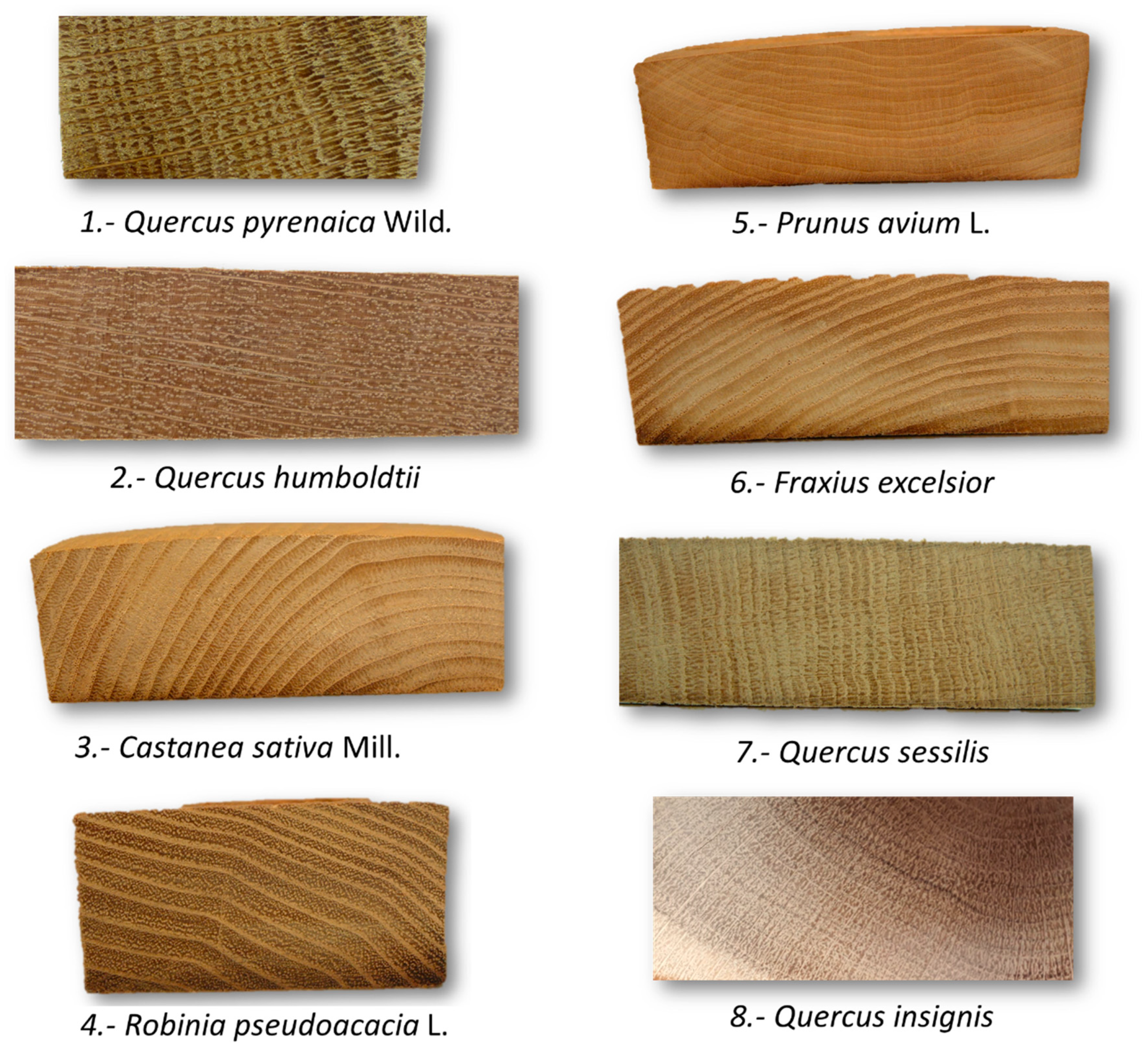
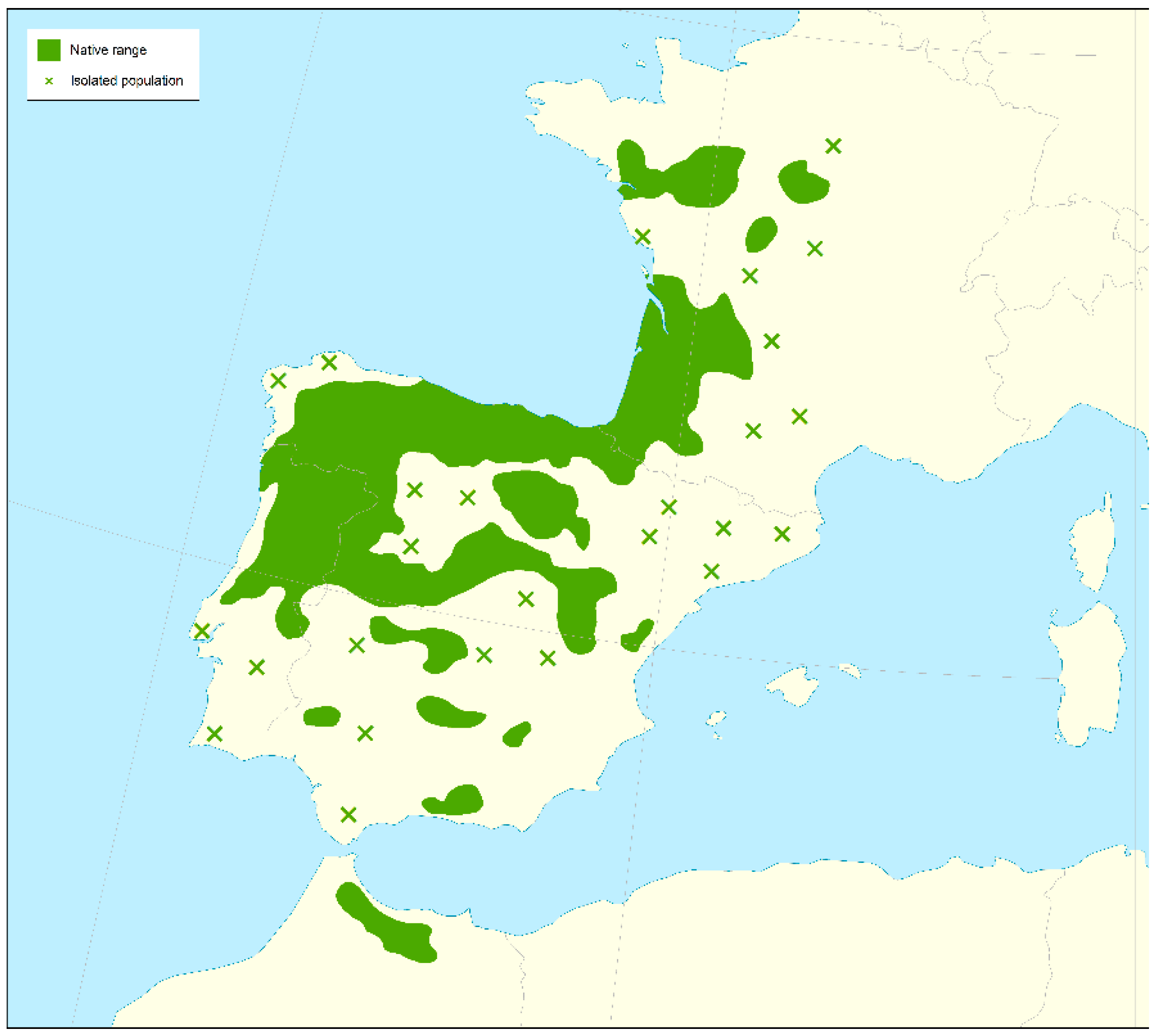
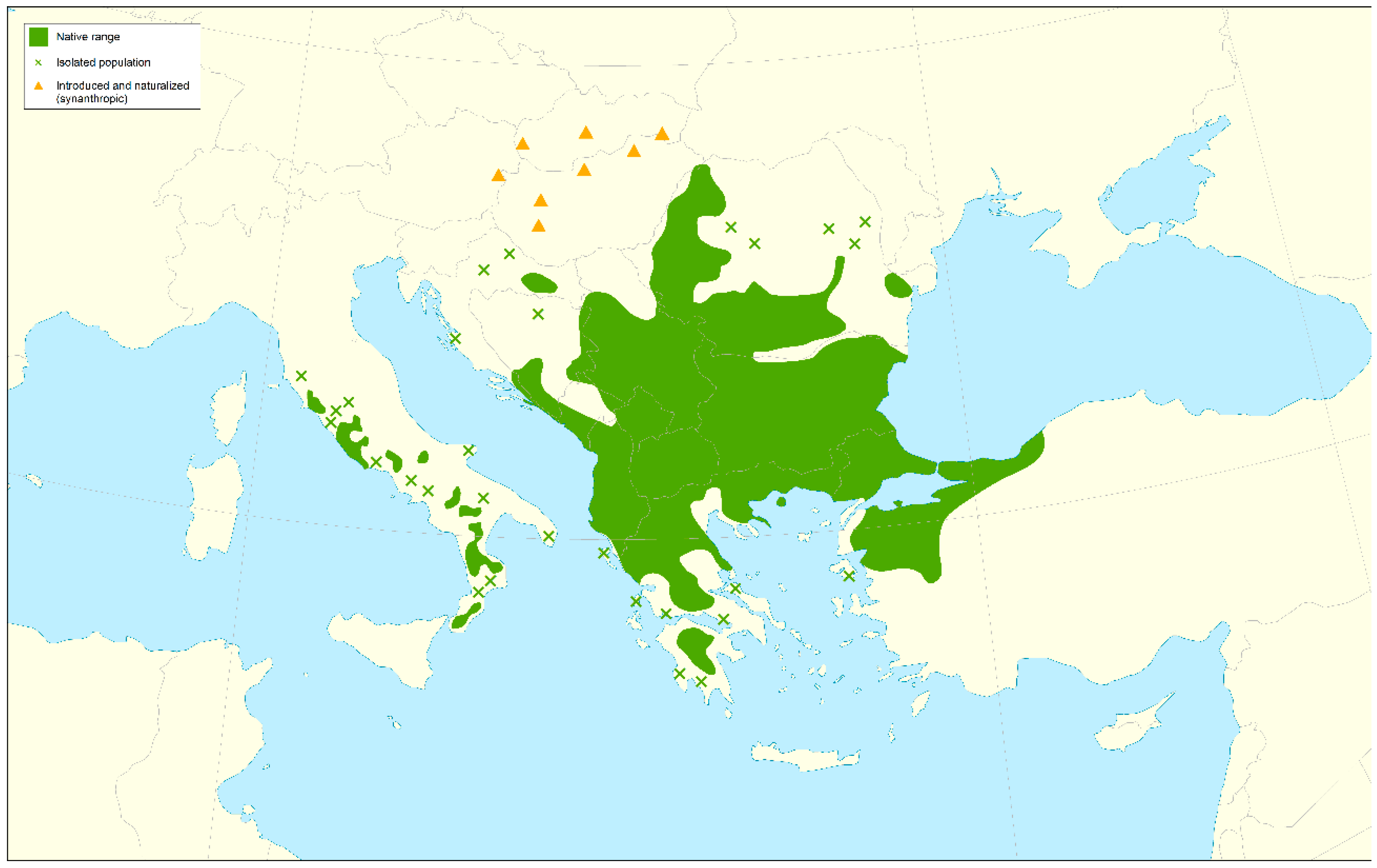
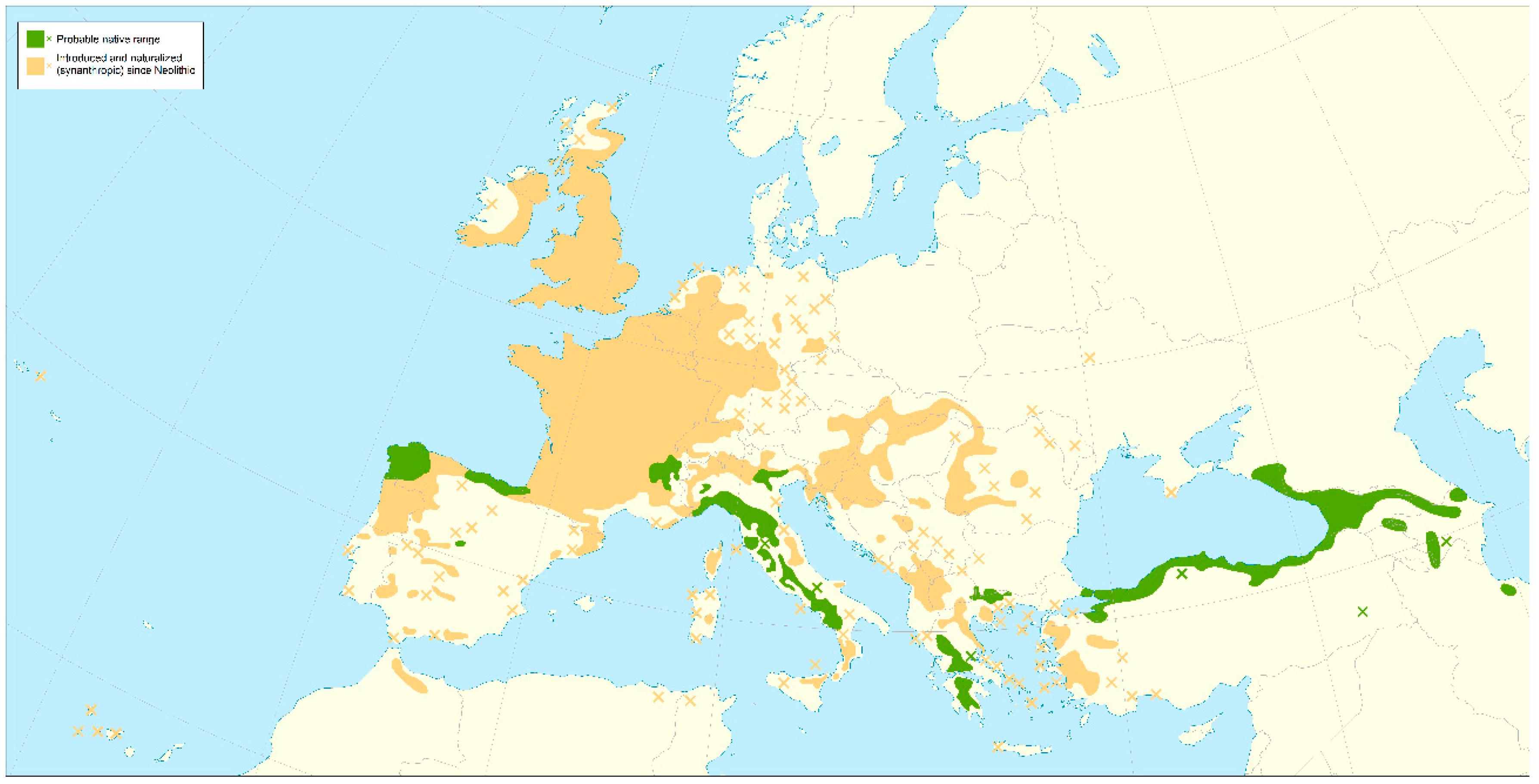
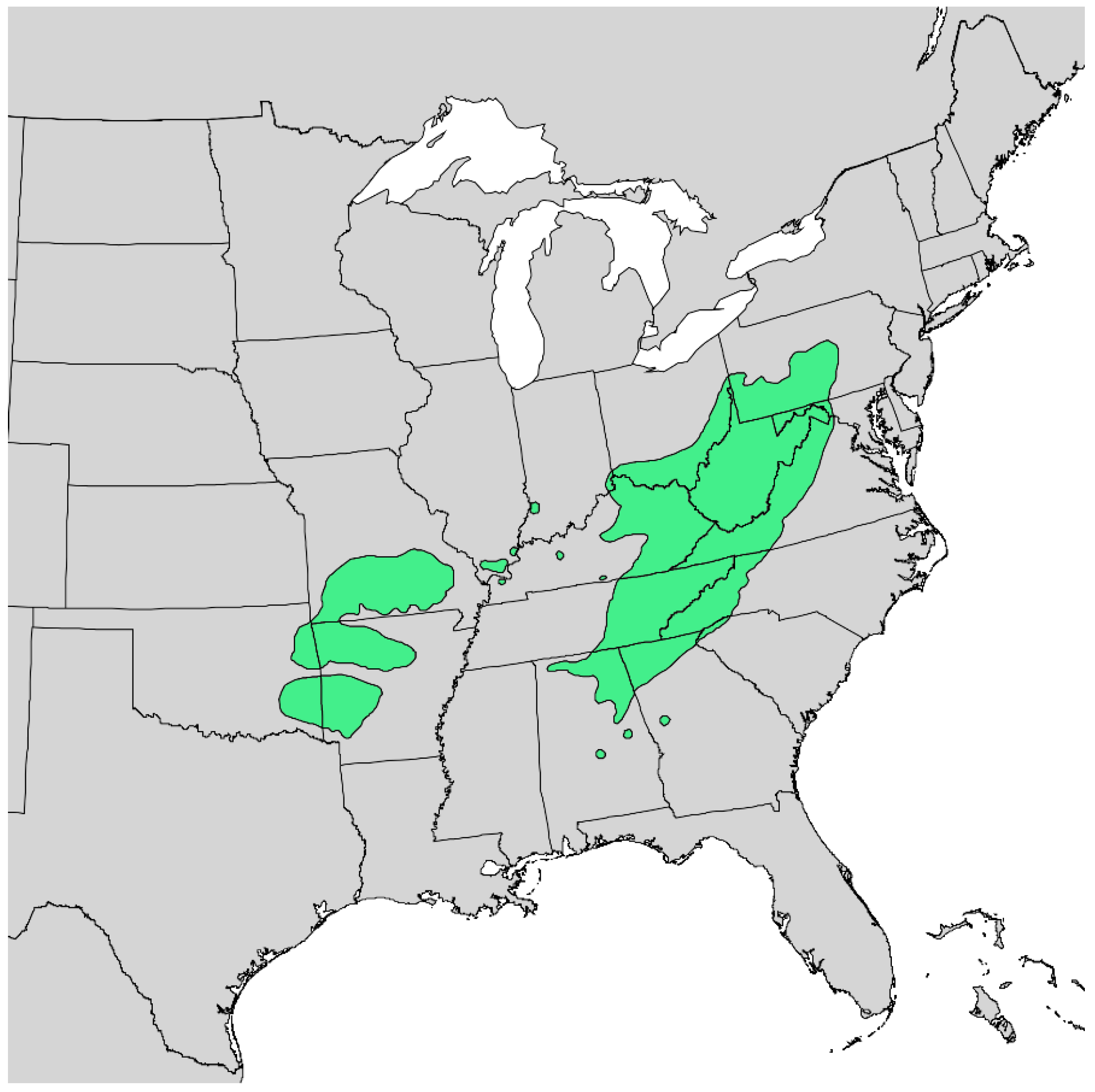
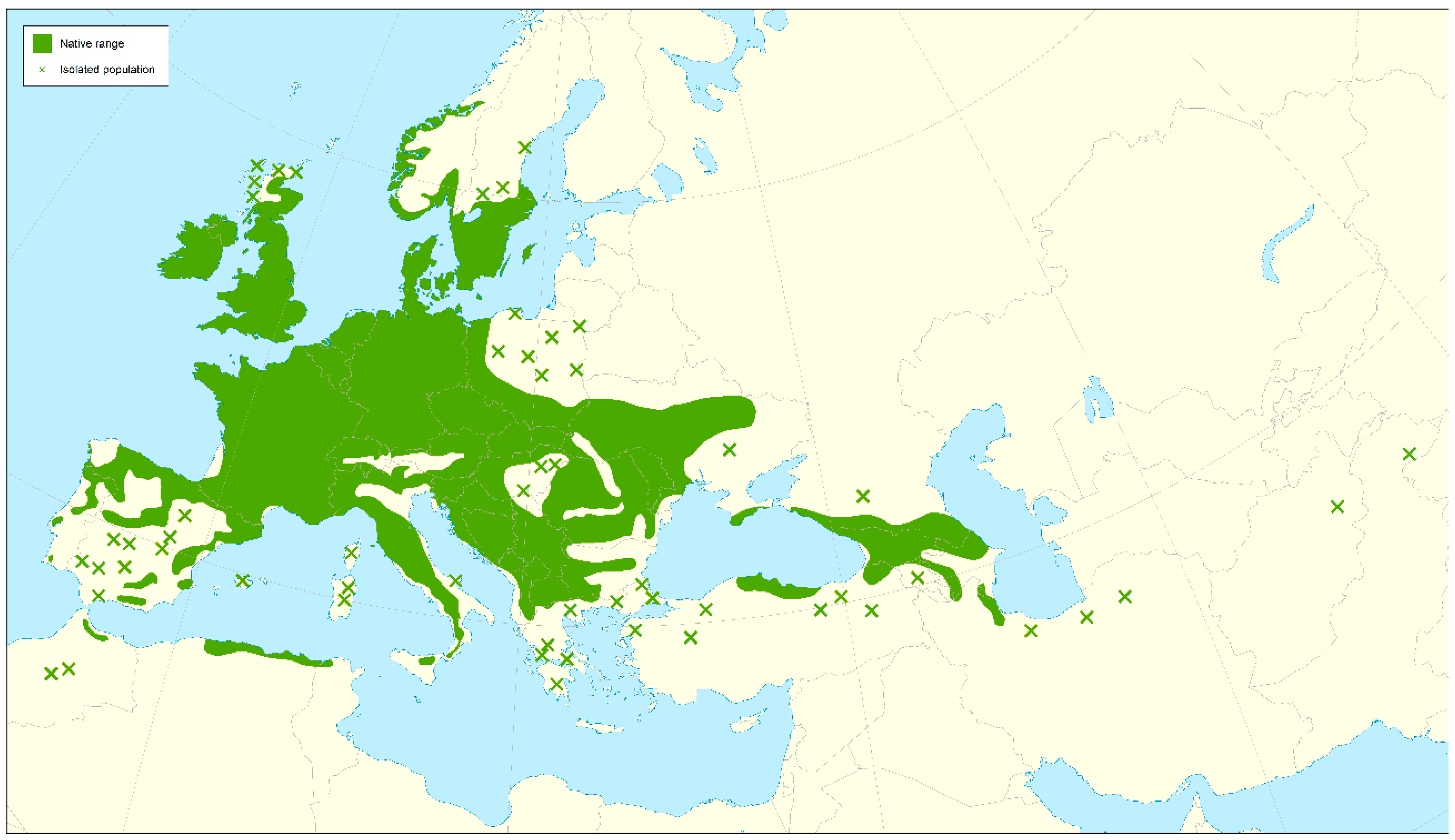
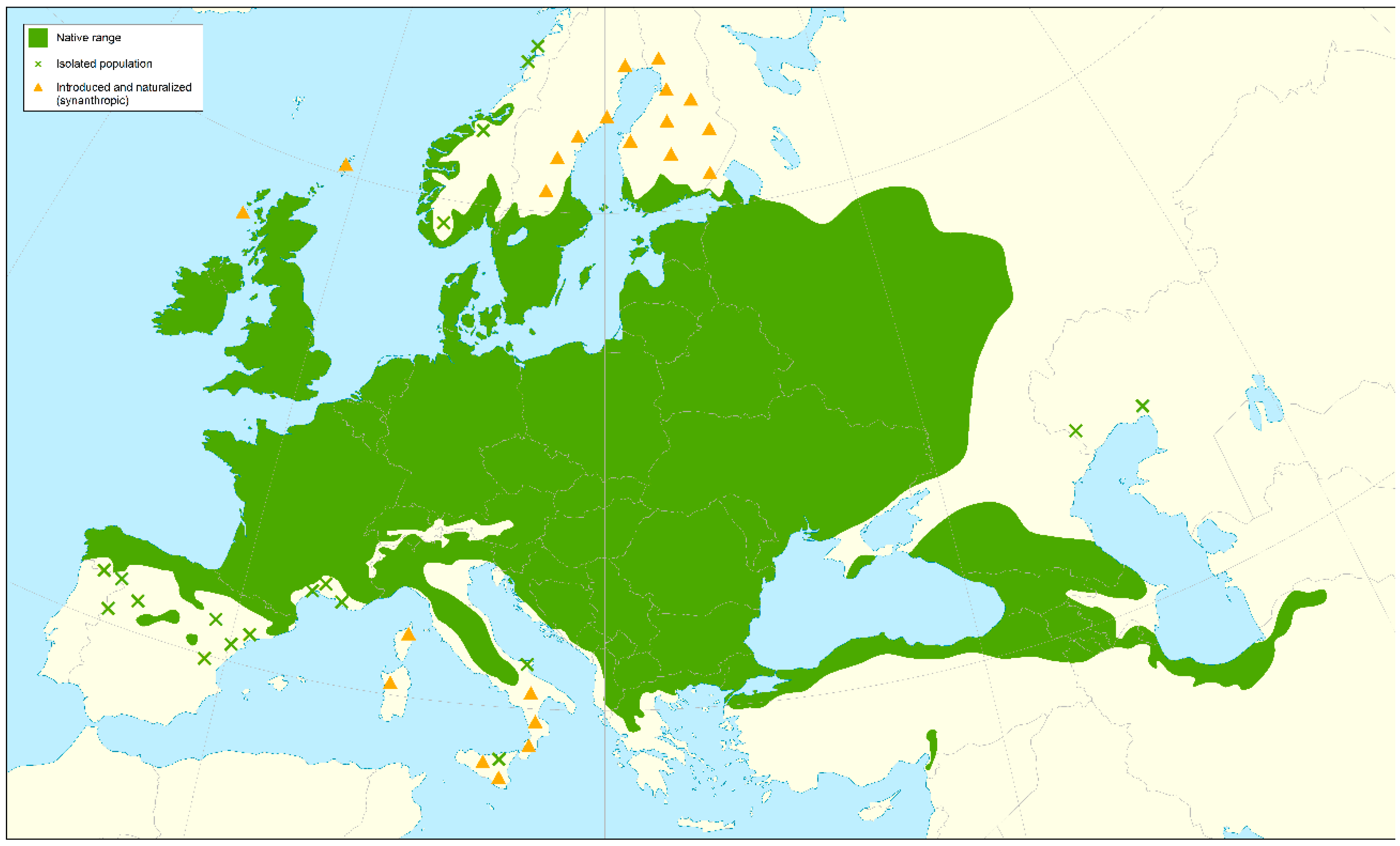
| Treatment | Species | Concentration Range Ellagitannins (mg/g) * | References | Concentration Range LMWP (µg/g) * | References |
|---|---|---|---|---|---|
| Untreated (green wood) | Quercus pyrenaica Willd. | 28.12–32.72 | [27,28,29] | 265–1061 | [23,27,28,30] |
| Quercus faginea Lam. | 32.51 | [28,29] | 407 | [28,30] | |
| Quercus frainetto Ten. | - | - | - | - | |
| Quercus oocarpa Liebm. | - | - | - | - | |
| Quercus humboldtti Bonpl. | 1.94 | [16] | 365 | [16] | |
| Castanea sativa Mill. | - | - | - | - | |
| Robinia pseudoacacia L. | - | - | - | - | |
| Prunus avium L. | - | - | - | - | |
| Prunus cereaus L. | - | - | - | - | |
| Fraxinus americana L | - | - | - | - | |
| Fraxinus excelsior L. | - | - | - | - | |
| Quercus petraea | 8.65–32.10 | [16,28,29] | 225–752 | [16,28,30] | |
| Quercus robur | 28.41–44.01 | [28,29] | 310–647 | [28,30] | |
| Quercus alba | 3.48–5.96 | [16,29] | 237–486 | [5,16] | |
| Seasoned | Quercus pyrenaica Willd. | 2.81–77.9 | [8,31,32,33] | 475–4304 | [7,28,31,33,34,35] |
| Quercus faginea Lam. | 24.11–26.97 | [8,28] | 760–1422 | [7,28] | |
| Quercus frainetto Ten. | 108 | [36] | 3800 *** | [36] | |
| Quercus oocarpa Liebm. | 33.9 | [36] | 5500 *** | [36] | |
| Quercus humboldtti Bonpl. | 1.61 | [17] | 832 | [17] | |
| Castanea sativa Mill. | 4.74–76.3 | [31,33,36,37,38] | 1155–14,430 | [31,32,33,34,36,37,38,39,40,41] | |
| Robinia pseudoacacia L. | nd | [42,43] | 41–408 | [40,42] | |
| Prunus avium L. | nd–0.04 | [31,43,44] | 6–620 | [31,44] | |
| Prunus cereaus L. | - | - | 228 | [40] | |
| Fraxinus americana L. | nd | [43,45] | 98 | [45] | |
| Fraxinus excelsior L. | nd | [43,45] | 53 | [45] | |
| Quercus petraea | 1.98–80.62 | [8,17,28,31,32,36,38] | 368–3400 | [7,17,28,31,34,38] | |
| Quercus robur | 3.93–87.4 | [8,31,32,36] | 647–4166 | [7,28,31,34,45] | |
| Quercus alba | 0.88–35.64 | [8,17,31,32,36] | 469–1064 | [7,17,31] | |
| Toasted | Quercus pyrenaica Willd. | 4.32–47.05 | [8,32,33,46] | 607–20,500 | [7,33,35] |
| Quercus faginea Lam. | 9.34 | [8] | 2132 | [7] | |
| Quercus frainetto Ten. | - | - | - | - | |
| Quercus oocarpa Liebm. | - | - | - | - | |
| Quercus humboldtti Bonpl. | 0.12 | [17] | 2464 | [17] | |
| Castanea sativa Mill. | 0.66–10.51 | [33,37] | 1353–35,282 | [7,33,35,37,40,47,48] | |
| Robinia pseudoacacia L. | nd | [42,49] | 6–2496 | [40,42,44,46] | |
| Prunus avium L. | nd | [43,46] | 90–3378 | [44,46,48] | |
| Prunus cereaus L. | - | - | 445–1578 | [40] | |
| Fraxinus americana L. | nd | [43,45] | 1915–3062 | [45] | |
| Fraxinus excelsior L. | nd | [43,45] | 1922–3585 | [45] | |
| Quercus petraea | 3.53–56.76 | [8,17,32,46] | 856–4420 | [7,17,32,46] | |
| Quercus robur | 7.72–11 | [8] | 2067–8225 | [7,40,47,48] | |
| Quercus alba | nd–5.89 | [8,17,32,46] | 460–3620 | [7,17,32,46,47] |
| Treatment | Species | Guaiacol | Eugenol | Furfural | Trans-β-Methyl-γ-Octalactone | Cis-β-Methyl-γ-Octalactone | Vanillin | References |
|---|---|---|---|---|---|---|---|---|
| Untreated (green wood) | Q. pyrenaica Willd. | 0.16–0.24 | 1.47–5.71 | 1.35–2.56 | 0.84–29.37 | 14.35–59 | 3.42 | [27,50] |
| Q. petraea | 0.09 | 2.05 | 1.19 | 18.4 | 36.9 | 2.19 | [50] | |
| Seasoned | Q. pyrenaica Willd. | nd–1.25 | nd–7.28 | 1.94–19.7 | nd–33.8 | 5.3–68.2 | 1.6–25.24 | [27,51,52,53,54,55] |
| Q. faginea Lam. | 0.29 | 1.98 | 17.6 | 1.74 | 15.5 | 10.6 | [51] | |
| Q. humboldtti Bonpl. | 0.1 | 2.65 | nd | nd | 0.02 | 1.97 | [17] | |
| Castanea sativa Mill. | nd–0.38 | 0.71–4.47 | 2.27–6.72 | nd–0.23 | nd–0.34 | 2.90–24.40 | [53,55,56,57] | |
| Robinia pseudoacacia L. | nd–0.86 | nd–0.21 | 0.45–0.92 | nd | nd | 1.65–3.48 | [55,56,57] | |
| Prunus L. | nd–0.53 | nd–0.11 | 0.49–0.66 | nd | nd | 0.13–2.42 | [55,56,57] | |
| Fraxinus americana L. | 0.08–0.13 | 0.19–0.57 | 0.54–0.8 | nd | nd | 7.25–10.3 | [55,57] | |
| Fraxinus excelsior L. | 0.11–0.22 | 0.44–0.94 | 1.21–1.31 | nd | nd | 1.39–14.7 | [55,57] | |
| Q. petraea | nd–1.3 | 0.57–6.5 | 3.4–19.9 | 0.09–14.7 | 0.42–55.9 | 2.0–18.8 | [50,51,53,54,55] | |
| Q. robur | 0.08–0.11 | 1.01–1.58 | 4.51–10.8 | 2.87–3.98 | 2.83–22.9 | 1.21–15.9 | [51,53] | |
| Q. alba | 0.04–3.3 | 1.38–5.9 | 1.2–4.68 | 2.52–5.0 | 22.3–32.5 | 6.8–7.9 | [51,54,55] | |
| Toasted | Q. pyrenaica Willd. | 0.11–8.91 | nd–14.6 | 19.6–4082 | nd–58.6 | 0.10–212 | 8.69–235 | [51,54,55,58,59,60] |
| Q. faginea Lam. | 0.36 | 2.35 | 96 | 1.08 | 3.25 | 258 | [51] | |
| Q. humboldtti Bonpl. | 3.74 | 3.34 | 533.53 | 0.06 | 0.3 | 22.36 | [17] | |
| Castanea sativa Mill. | 0.46–5.30 | 2.13–3.23 | 431–1675 | nd | nd | 7.15–143 | [55,57] | |
| Robinia pseudoacacia L. | 0.52–6.05 | 0.40–2.36 | 20.7–840 | nd | nd | 19.2–106 | [55,57] | |
| Prunus L. | 0.91–1.71 | 0.74–1.50 | 23–175 | nd | nd | 45–91.7 | [55,57] | |
| Fraxinus americana L. | 5.97–11.9 | 1.58–3.00 | 26.5–63.6 | nd | nd | 76.1–160 | [55,57] | |
| Fraxinus excelsior L. | 6.47–14.07 | 1.59–3.21 | 26.5–82 | nd | nd | 76.3–187 | [55,57] | |
| Q. petraea | 0.17–3.4 | 0.83–4.0 | 10.3–963 | 0.01–14.6 | 0.05–22.8 | 3.0–370 | [51,54,55,60] | |
| Q. robur | 0.17–0.53 | 1.01–1.37 | 8.90–10.8 | 3.41–3.98 | 2.83–22.9 | 130–172 | [51] | |
| Q. alba | 1.22–7.3 | 1.29–11.6 | 4.04–1539 | 3.29–7.4 | 16.1–45.5 | 7.5–102 | [51,54,55,60] |
© 2018 by the authors. Licensee MDPI, Basel, Switzerland. This article is an open access article distributed under the terms and conditions of the Creative Commons Attribution (CC BY) license (http://creativecommons.org/licenses/by/4.0/).
Share and Cite
Martínez-Gil, A.; Del Alamo-Sanza, M.; Sánchez-Gómez, R.; Nevares, I. Different Woods in Cooperage for Oenology: A Review. Beverages 2018, 4, 94. https://doi.org/10.3390/beverages4040094
Martínez-Gil A, Del Alamo-Sanza M, Sánchez-Gómez R, Nevares I. Different Woods in Cooperage for Oenology: A Review. Beverages. 2018; 4(4):94. https://doi.org/10.3390/beverages4040094
Chicago/Turabian StyleMartínez-Gil, Ana, Maria Del Alamo-Sanza, Rosario Sánchez-Gómez, and Ignacio Nevares. 2018. "Different Woods in Cooperage for Oenology: A Review" Beverages 4, no. 4: 94. https://doi.org/10.3390/beverages4040094
APA StyleMartínez-Gil, A., Del Alamo-Sanza, M., Sánchez-Gómez, R., & Nevares, I. (2018). Different Woods in Cooperage for Oenology: A Review. Beverages, 4(4), 94. https://doi.org/10.3390/beverages4040094








